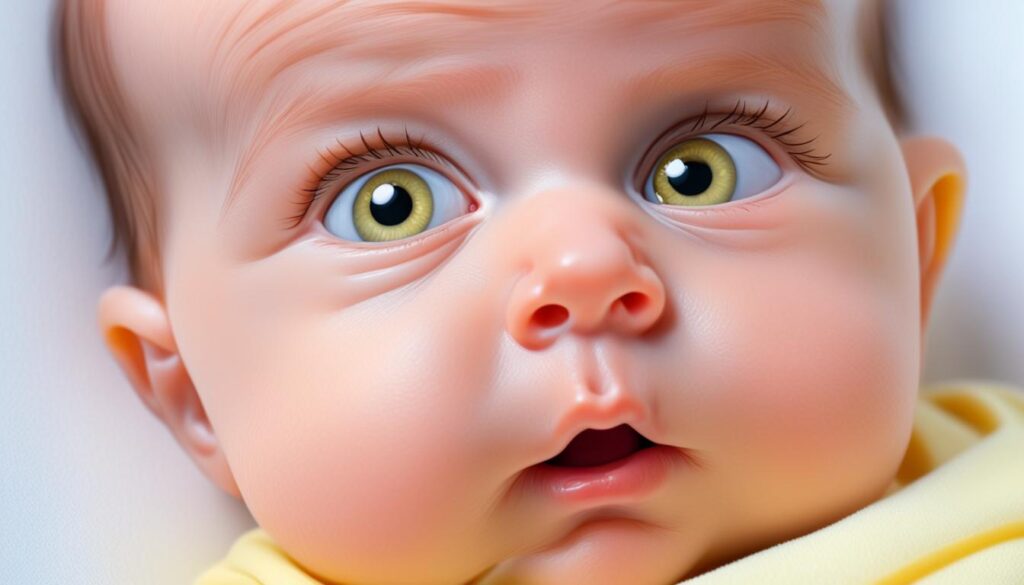Jaundice is when a baby’s skin and eyes turn yellow. It happens because there’s too much bilirubin. Bilirubin is the yellow stuff made when our bodies break down red blood cells. Most babies don’t need treatment for jaundice if they were born between 35 weeks and full term. But sometimes, jaundice can get so bad it might hurt the baby’s brain. You can tell if a baby has jaundice by gently pressing their forehead or nose. If you see jaundice, get medical help fast, because it can cause serious problems like brain injury.
Table of Contents
ToggleOverview of Jaundice in Newborns
Jaundice is common in newborns, especially preterm babies and some who are breastfed. The baby’s liver is not fully developed yet. So, it can’t get rid of the yellow substance called bilirubin quickly. Sometimes, an illness adds to the jaundice.
Most babies between 35 weeks and full term don’t need jaundice treatment. But, very high bilirubin levels could hurt the brain if not treated. So, it’s vital to watch for jaundice signs and get medical help if needed quickly.

Some things make severe jaundice more likely, like being born early, big bruises at birth, blood type differences between mom and baby, or nursing issues. Handling these issues well can lower jaundice risks.
Knowing about jaundice’s causes and risks, and acting early, helps keep babies safe. Parents and doctors can team up. They should watch and care for jaundiced newborns to protect them from harm.
What is Jaundice in Babies?
Definition of Jaundice
Jaundice makes a newborn’s skin and eyes look yellow. It happens when there’s too much bilirubin, a yellow-red pigment, in the blood. This is common, especially in babies born early or those who are breastfed.
Common Occurrence in Newborns
Many newborns get jaundice. It happens because their liver isn’t fully developed. This makes it hard for them to remove bilirubin quickly.
Preterm babies are more at risk. They might not process bilirubin as efficiently as babies born at full term.

Causes of Jaundice in Infants
The main reason infants get jaundice is from too much bilirubin. This is because of their high red blood cell activity. Their liver is not fully developed. So, it can’t clear out the bilirubin fast enough. This makes their skin and eyes turn yellow.
Excess Bilirubin Production
Newborns have lots of red blood cells. This leads to more breakdown and bilirubin production. Their liver might struggle to remove the bilirubin. This results in jaundice.
Immature Liver Function
A baby’s liver is not as good at removing bilirubin as an adult’s. This can cause physiologic jaundice. This is common in newborns.
Underlying Disorders
Sometimes, jaundice signals a deeper health issue. It can be from internal bleeding, infections, or liver problems. Even certain blood disorders can lead to too much bilirubin.

Risk Factors for Severe Jaundice
Infant jaundice is common. But, some babies face a higher risk of severe jaundice. This can lead to health problems. Parents and doctors must know these risks. This helps in quick diagnosis and effective treatment.
Premature Birth
Babies born early, before 38 weeks, are at risk. Their livers may not be fully developed. This affects how they handle bilirubin. Bilirubin is a yellow substance that gives skin and eyes a yellow tint.
Birth Injuries and Bruising
Problems during birth can also be a risk. If the baby has a lot of bruises, more red blood cells might break down. This means more bilirubin in the baby’s body, causing severe jaundice.
Blood Type Incompatibility
When the mother’s and baby’s blood types don’t match, it can be a problem. The baby might make antibodies that break down red blood cells. This raises bilirubin levels and the risk of severe jaundice. It happens most often with an Rh-negative mother and an Rh-positive baby.
Breastfeeding Challenges
Jaundice is more likely in breastfed babies who have trouble nursing. If they don’t get enough milk, they might get dehydrated. Not enough food can also lead to jaundice.

Symptoms of Jaundice in Babies
Infant jaundice shows first by the baby’s skin and eyes turning yellow. This happens between the second and fourth day after birth. To check, press on the baby’s forehead or nose gently. If the skin looks yellow, it may be jaundice.
Yellowing of Skin and Eyes
Jaundice makes the skin and the whites of the eyes turn yellow. This is because of too much bilirubin in the body. Bilirubin is a yellow pigment from breaking down red blood cells. It makes the baby’s skin and eyes yellow, which is a clear sign of jaundice.
Additional Warning Signs
Severe jaundice comes with more signs. This includes the skin getting more yellow, and the body parts turning yellow too.
Other signs are the baby being less active or not feeling well, having difficulty feeding, crying in a high-pitched way, and having a fever. If you see these signs, get medical help right away.

When to Seek Medical Attention
Most hospitals check newborns for jaundice before they leave. The American Academy of Pediatrics suggests all babies get checked for jaundice often. If your baby leaves the hospital before 72 hours, follow up within two days for a jaundice check.
Notice if your baby’s skin or eyes get yellower. If your baby seems unusually tired or hard to wake, see a doctor right away. These signs mean your baby might have jaundice that needs quick medical care. Finding and treating jaundice early can avoid serious problems.

Diagnosis and Evaluation
Your pediatrician will do a full check to find out about infant jaundice. They’ll look closely at your baby’s skin and eyes for any yellowing. This is a key step in detecting jaundice. They might also gently press on your baby’s forehead or nose.
This physical exam is crucial. It helps the doctor understand the jaundice’s seriousness.
Apart from the exam, your doctor will also ask for a blood test. This test will show your baby’s bilirubin level. Bilirubin causes the yellow color linked with jaundice. Knowing the bilirubin levels is very important for the right treatment. Fast diagnosis and watching the bilirubin levels can help avoid serious jaundice problems.
Treatment Options for Jaundice
If your baby has jaundice, several treatments can help. The main ones are phototherapy and sometimes exchange transfusion.
Phototherapy (Bili Lights)
Phototherapy, or bili lights, is a top treatment for jaundice. A baby is put under a special lamp. This lamp helps the body remove bilirubin through urine and stool more easily.
This type of treatment uses lights or a bili blanket. The blanket is soft and wraps around the baby.
Exchange Transfusion
Sometimes, phototherapy isn’t quick enough. In these cases, a baby might need an exchange transfusion. This is when the baby’s blood is partly replaced with donor blood.
It’s a rare procedure. But it’s very effective for severe jaundice that doesn’t respond to other treatments.
Complications of Untreated Jaundice
If severe jaundice isn’t treated, it can cause serious problems. For example, there’s a risk of acute bilirubin encephalopathy. This can damage the brain in newborns and lead to long-term issues like hearing loss. It also often affects how teeth develop and can cause involuntary movements.
Kernicterus
Another severe issue from untreated jaundice is kernicterus. This is when the brain suffers deep and lasting harm from acute bilirubin encephalopathy. Kids with kernicterus might end up with athetoid cerebral palsy, gaze problems, and hearing issues.
Acting quickly on jaundice is key to avoiding these big problems. Keep an eye out for signs, and get medical help fast if jaundice is severe. Doing this can protect your baby from the life-changing impact of not treating serious jaundice.
Prevention and Management Tips
The best way to stop infant jaundice is through good feeding. Dehydration and not eating enough can cause jaundice. Infant needs vary between breast-fed and formula-fed babies. For breast-fed infants, feed them 8-12 times a day in the first days. Formula-fed babies should consume 1-2 ounces of formula every 2-3 hours. This helps avoid jaundice.
Adequate Feeding
Proper nutrition is key in controlling jaundice in newborns. Making sure your baby gets the right amount of nutrition, from either breastmilk or formula, is vital. This aids in removing bilirubin and stops jaundice from getting worse. Newborns fed with breastmilk need 8-12 feedings daily in their early days. Formula-fed infants do well with 1-2 ounces every 2-3 hours. This ensures they get enough nutrition to fight jaundice.
Close Monitoring
Besides feeding, you need to watch your baby for jaundice signs. Make it a habit to check your baby’s skin color. If it looks yellow, see the doctor right away. Early detection and care can prevent serious issues. Also, watch for any changes in your baby’s behavior or skin tone. Always reach out to the doctor if worried about spotting jaundice.
Conclusion
Jaundice is a common and usually harmless condition in newborns. It happens when there’s too much bilirubin. Most cases go away on their own. But, if not treated quickly, it can cause serious problems.
Parents can keep their babies safe by understanding jaundice. They should know the causes, signs, and treatments. Doing so can make sure their babies are healthy.
Feeding babies well, especially through breastfeeding, helps. So does watching for jaundice signs closely. Getting medical help fast is key. It prevents risks like seizures and mental problems.
For parents, dealing with jaundice is scary but doable. By being alert and getting help when needed, they can protect their baby. This means their baby’s health and future won’t be harmed by jaundice’s worst effects.
FAQ
What is jaundice in babies?
What causes jaundice in infants?
What are the symptoms of jaundice in babies?
How is jaundice in infants treated?
What are the potential complications of untreated jaundice?
How can parents help prevent jaundice in their newborns?
Source Links
- https://www.mayoclinic.org/diseases-conditions/infant-jaundice/symptoms-causes/syc-20373865
- https://www.nationwidechildrens.org/conditions/jaundice-in-children
- https://www.nhs.uk/conditions/jaundice-newborn/
- https://my.clevelandclinic.org/health/diseases/22263-jaundice-in-newborns
- https://www.nhs.uk/conditions/jaundice-newborn/causes/
- https://www.ncbi.nlm.nih.gov/pmc/articles/PMC9253931/
- https://www.mayoclinic.org/diseases-conditions/infant-jaundice/diagnosis-treatment/drc-20373870
- https://www.nhs.uk/conditions/jaundice-newborn/treatment/
- https://www.webmd.com/parenting/baby/digestive-diseases-jaundice
- https://www.ncbi.nlm.nih.gov/pmc/articles/PMC2528723/


